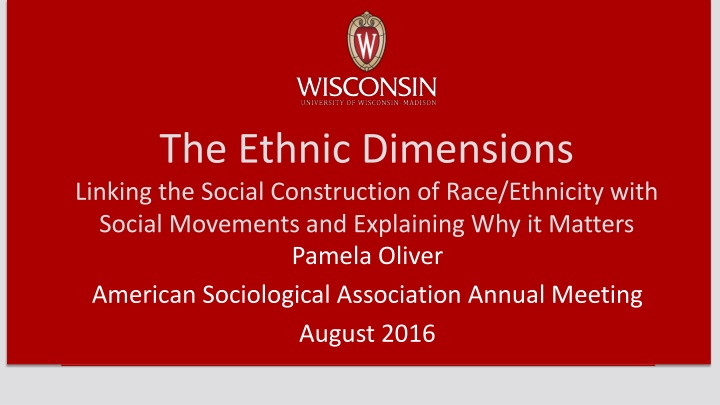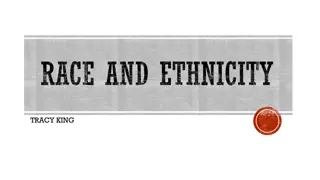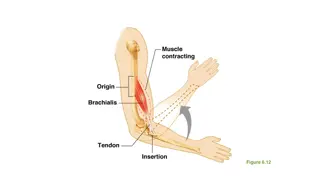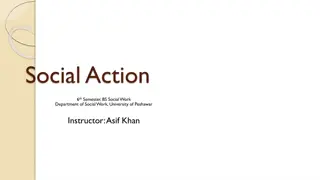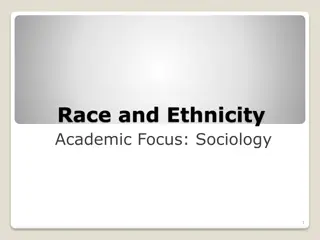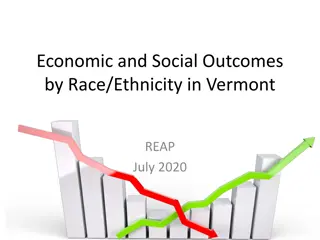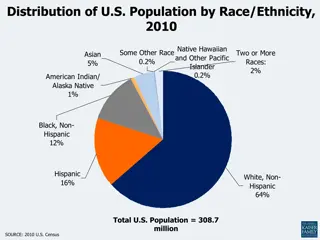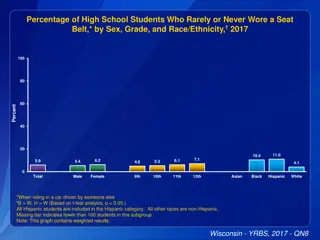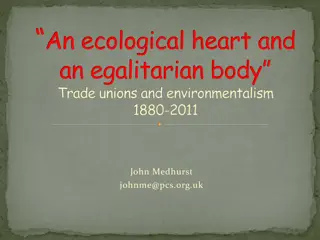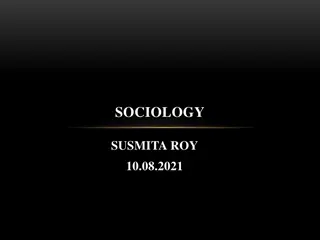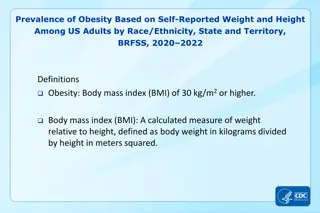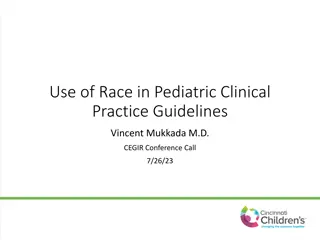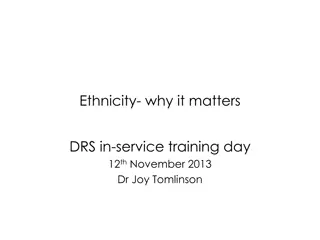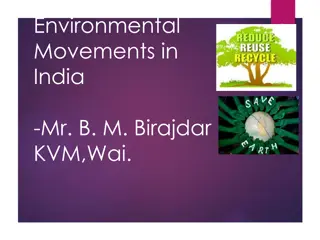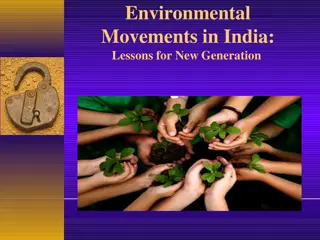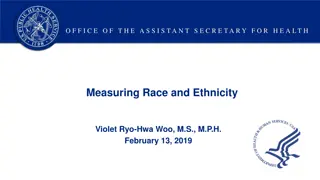The Significance of Ethnicity and Race in Social Movements
Exploring the interconnectedness between the social construction of race/ethnicity and social movements, this presentation by Pamela Oliver delves into the relevance of race in both majority and minority movements. It emphasizes how race/ethnicity plays a crucial role in structures of domination, power dynamics, and network configurations within movements. The talk highlights the distinct tasks and challenges faced by movements of the oppressed versus those of the privileged, shedding light on the importance of understanding ethnic and racial dimensions in social activism.
Download Presentation

Please find below an Image/Link to download the presentation.
The content on the website is provided AS IS for your information and personal use only. It may not be sold, licensed, or shared on other websites without obtaining consent from the author.If you encounter any issues during the download, it is possible that the publisher has removed the file from their server.
You are allowed to download the files provided on this website for personal or commercial use, subject to the condition that they are used lawfully. All files are the property of their respective owners.
The content on the website is provided AS IS for your information and personal use only. It may not be sold, licensed, or shared on other websites without obtaining consent from the author.
E N D
Presentation Transcript
The Ethnic Dimensions Linking the Social Construction of Race/Ethnicity with Social Movements and Explaining Why it Matters Pamela Oliver American Sociological Association Annual Meeting August 2016
Outline Why race/ethnicity is important: social construction of race & social movements Ethnic typology of movements (majority vs minority) Broader implications (fast) NOTE: The written paper has lots of citations to the many people who have written about the social construction of race/ethnicity and about racial/ethnic social movements. This talk has almost no citations. I am just trying to lay out the argument. But if you know the literature, you will recognize that very little of what I have to say about the social construction of race/ethnicity is original. I m summarizing the literature & linking it to SM.
Main take-aways Social construction of race/ethnicity IS NOT just personal, subjective; NOT there is no such thing as race about state formation, power, & structures of domination about networks and kinship, relationships and the social structure about social movements Race/ethnicity is relevant to ALL movements, majority as well as minority. Pay attention to the Whiteness/majority-ness of White/majority movements. Pay attention to White/majority supremacy as an issue in ALL movements, not just overt White nationalist movements Pay attention to minority movements on their own terms and the dynamics of minority structural position
Movements by the oppressed & the privileged Morris & Braine: Movements by and for oppressed people have different tasks. Resource deficits, repression Identities are ascribed Cultures of subordination intermixed with cultures of opposition; overcoming fear is an issue Movements by and for the privileged have the opposite configuration. Identity development more problematic (M&B don t stress): Privileged people develop habits of dominance and entitlement as well as having more resources & facing less repression Extending Morris & Braine Not all axes of domination have the same network structure. Ethnicity vs. gender Race/ethnicity is relevant to dominant groups. White racist groups and clueless White groups need analysis, too
Why is ethnicity/race important to social movements? Ethnicity/race is often a basis of a structure of domination, central to states. Ethnicity/race is often a major network & interest cleavage
Social construction of race/ethnicity I Ethnicity/race is intertwined with state formation and is a structure of domination
Majorities and Domination History: Colonialism, War, Conquest, Slavery, Etc. Numerical Majority: Sheer numbers Economic Power & Resources Political Power
Ethnicity/race and states State formation typically has an ethnic dimension (Olzak, Wimmer, Brubaker, many others) United States of America was founded as a White nation. Tyranny of the majority, the dark side of democracy. Social control (policing, incarceration) is often biased by race/ethnicity.
Dimensions of ethnic/racial domination Legal definitions of citizenship. Voting rights. Residence rights. Numerical majorities & democracy; size of minority affects voting strength. Material wealth. Social closure, unequal distribution of resources. State policies favoring some groups State policies the prevent reparations or other ways of undoing past biased actions Repression/policing Culture (next slide)
Cultural domination Whose country it is: national definitions, language, etc. Requirements for cultural assimilation, sometimes forced. (e.g. Indian boarding schools, suppression of minority history & sanitizing nation- formation in standard US history classes, dress codes that ban Black hair styles and clothing styles) Intermingling of cultures of opposition & subordination among the oppressed Having to learn habits of survival, adaptation Intermingled with anger, hostility, frustration [health consequences of these emotional tensions] Cultures of domination: habits of efficacy, entitlement, cluelessness
Social Construction of Race/ethnicity II Ethnicity/race is ascribed and networked and a basis of social cleavage
Ethnicity is inherited Ethnicity/race is inherited from parents (with complications: mixed ancestry, immigrant assimilation) Runs in families, kinship groups, communities Ethnic structure is always relevant Ascription: assigned to you, you don t choose it Interplay of ascription and achievement in asserting identities Mixed cases, continuum of ascription/achievement not really a dichotomy Politics & state definitions affect ascription
Ethnicity is often a basis for network cleavage Ethnicity/race does not have to be a basis of network cleavage, but it often is Inheritance of ethnicity from parents means it can and generally does run in families Kinship networks can be and often are mono-ethnic/race Residential communities can be and often are mono-ethnic/race Political rules & structures of domination may reinforce this Discrimination and segregation increase network cleavages
Network cleavages create interest cleavages
Network interests Tied to place e.g. toxic waste, traffic, noise Economic multipliers: Stores, churches, jobs Tied to social connections Kinship support, economic transfers among family Support networks for bad times Emotional reactions: grief, fear, optimism, pessimism. Cultural capital : knowledge of how things work Cross-cutting vs overlapping cleavages A long-standing topic of sociology Ethnic conflict literature stresses the question of the correlation between class and ethnicity But there is more, there is the actual connections. And imagined identities
Communities of discourse Sharing information, world views Political/religious subcultures Racial cultures (e.g. support for White supremacist ideology) Communities of sympathy Reactions to national or racial incidents
Putting it together: networks, discourses, states, social movements
Collective identities, consciousness, and organization reinforce each other Group Identity Group Group Organization Consciousness
Social movements affect and are shaped by the formation of collective identities Group Identity Social Movements Group Group Organization Consciousness
Segregation and domination reinforce group difference (ethnicity/race) Domination Ascription & Inheritance & Difference Network Segregation
External group boundaries tend to reinforce internal group & identity formation External Ethnic Dimensions Internal Ethnic Dimensions Group Identity Domination Ascription & Inheritance & Difference Group Group Organization Social Segregation Consciousness
Social movements are central to the construction of race/ethnicity External Ethnic Dimensions Internal Ethnic Dimensions Group Identity Domination Ascription & Inheritance & Difference Group Group Organization Social Segregation Consciousness Social Movements
Theoretical connections Political Conflict, Migration & State Formation: Conquest, Colonialism, Immigration Social Movements & Group Making and the Social Construction of Ethnicity Ethnic Character of States Network effects: Interests & Influence Majorities and Minorities Identities and consciousness Ethnicity networks & intergenerationality Structures of Domination
Ethnic typology of movements Majority Vs Minority Movements
Social movements vary in the ethnic (and class) composition of their movement carriers
Types Group focused promoting majority (e.g. White supremacist, Hindu nationalist) Group focused promoting a group subordinated on a different axis (e.g. working class, women s, gay rights) Issue-focused on issues affecting society as a whole e.g. peace, environment, animal rights) Group-focused ally movements promoting interests of ethnic minorities (This type is comparable to mixed majority-minority)
Majority movements often are or become hostile to minorities White labor movement & White women s movement were explicitly racist Populist movements are often anti-minority Many general issues become racialized, e.g. welfare, crime control. Why this happens is less well understood. Partly network isolation makes people ignorant of others and foments stereotypes, leading to possibility of us-them dynamic. McVeigh and the conditions under which a white racist interpretation of the facts makes sense. McKean argues that populism with its us-them rhetoric presupposes a homogeneity in the us as a source of this tendency.
Network isolation and cluelessness Even non-hostile majority movements are often clueless about minorities and fail to recognize divergence of interests Network segregation + culture of domination makes majorities genuinely ignorant of needs of others
Majority movement advantages More resources More electoral power More integration with larger society More connections with political elites Less likely to be repressed More able to use violence and get away with it Cultural assumptions of efficacy, entitlement: expect to have their needs & desires met
Majority identity issues Majorities often have no conscious ethnic identity; identity selves with nation Conscious ethnic identities tend to be hostile toward minorities Movement identities generally chosen, don t feel imposed. But movements need to build & create these identities, people don t just have them There may be proto-ethnic subcultures (religious, political) that people are socialized into
Majority culture issues Hughey: [male] White supremacists and White anti-racists had very similar cultures, views of themselves as White, and in how they talked about Blacks and other minorities. Majorities may be unaware of their culture, believe there is something wrong with people who are not like them Cultural assumptions of efficacy and entitlement: used to getting what they want. Limitations by class, gender
Types Group-oriented pro-minority Civil rights, reform (integrationist, assimilationist); these can be radical or moderate. There were militant radical integrationists. Separatists, nationalist NOTE: Ethnic conflict literature focuses on question of when/where such movements arise NOTE: Either integrationist or separatist movements can be radical or moderate. Intersectional: link ethnicity/race to other issues, e.g. women of color reproductive rights (Sister Song), environmental racism, Black Lives Matter focus on police violence. Place-based community movements or class-based movements that are empirically minority
Disadvantages Lower political power, count less electorally and may be disenfranchised Typically economically disadvantaged Segregated networks makes them less connected to national discourses, harder to get attention to issues Typically need allies to have enough power to win have to deal with ally issues and mixed ethnicity movements or coalitions
Cultures Awareness of disadvantage is the norm for ethnic minorities Oppositional culture is the norm Culture typically interweaves elements of opposition with elements of subordinate or submissive culture and fear; accommodation, survival strategies Consciousness-raising involves overcoming a sense of powerlessness and fear, rather than learning about issues
Dominant Majority Subordinate Minority Political power High, can achieve goals without other groups Low, needs allies Resources Relatively high Relatively low Identities Latent, need to be developed. Often unmarked. I.e. a White group is seen as an unraced group. Given, recognized from childhood Culture Habits of dominance, entitlement, unthinking Mixture of opposition and subordination Consciousness raising Education or motivation about issues or other groups Overcome fear, sense of powerlessness Networks Internal Weaker, movement often organization based; majority supremacy tied to communities Stronger, movements often community based Networks: external Connected to the majority of society If segregated, isolated from the majority of society Frames Tend to see themselves and be seen as the whole society, their issues are national issues Their issues tend to be seen as special interests
Types Majority-dominated movements with substantial minority participation General issues (e.g. peace, environment) Other axes of domination (gender, class) Ally movements: majorities working for minority group issues Professional helper movements: professional advocates for disadvantaged beneficiaries.
Issues & Tensions Privilege & Hierarchy: majority habits of domination even in ally or mixed groups. Overt conflict around this Minorities often withdraw due to these issues Power & resources: who has access, can actually accomplish the goals Cultural Practices: how you hold a meeting, polite forms of speech Agenda: scope of goals (majority typically more limited, minority more racdical and sweeping, but also what goals are most important)
Mixed minority Types: Coalitions of different minorities Place- or class-based movements that are empirically mixed minority There are examples of successful alliances Such groups often combine the structural weakness of minority movements with the cultural conflicts of mixed majority-minority movements
Ethnic/racial hierarchies matter Majority-minority dynamics: power and privilege Access to power Level of repression, safety in using militant tactics Resources Network cleavage Overlapping cleavages, divergent interests between groups and overlapping and network interests within groups Different universes of discourse Intergenerationality: mapping of movement onto families, kinship, community
The Ethnic Dimensions are Analytic Domination What is the difference in power and privilege between groups? Are the group s issues seen as general issues or specific? Are there cultures of dominance/entitlement vs. submission/fear Networks Are the groups physically and socially segregated? Are there overlapping or cross-cutting cleavages? Generations How does group membership map onto family and kinship? Are children socialized into group membership? Are the groups endogamous?
Dan Savage about how quickly opinions about gay marriage changed "Are you surprised the culture around gay marriage has changed so quickly? "I am. In 2004, when all those anti-gay marriage amendments passed and George Bush got reelected, I thought this will never happen in my lifetime. But we kept fighting. The secret weapon is, we're randomly distributed throughout the population and in all families. If you don't have a gay, lesbian, bi, trans in your immediate family, there's probably one in your extended family. Definitely your extended family. That is our secret weapon, and that humanizes us. If African Americans were randomly distributed throughout the population and in every family, George Zimmerman would be in jail and so would that cop in Ferguson." From an interview with Dan Savage (Davidoff 2014).
Race/Ethnicity Gender Intergenerationality Typically the same within family & kinship Typically mixed within family & kinship Cleavages Hierarchies and domination between families Hierarchies and domination within families Networks and segregation Often physically segregated (and physical segregation reinforces cultural difference) Typically physically integrated Origins Origins in inter-group processes, invasion, colonialism, and state formation Origins in social organization of biological reproduction Physicality Differences may be seen as cultural or physical. Differences seen as physical with rules about cultural expression usually present.
Class, religion, politics Economic class is more like ethnicity if and when there is low inter-generational mobility so that people in the same extended families tend to be of the same class. there is class endogamy (marrying within class) there is residential and social segregation by class your parents class is defined as part of who you are, regardless of your own class Religion is more like ethnicity if and when it is defined as something you are born into, not something you choose there is religious endogamy (marrying within religion) your parents religion matters to your life chances regardless of your own beliefs there is physical and social segregation by religion Political ideology is more like ethnicity if and when there is political ideology endogamy and strong parent-child agreement in political ideology (so it runs in families) there is physical and social segregation by political ideology
The Ethnic Dimensions matter for social movements The End
